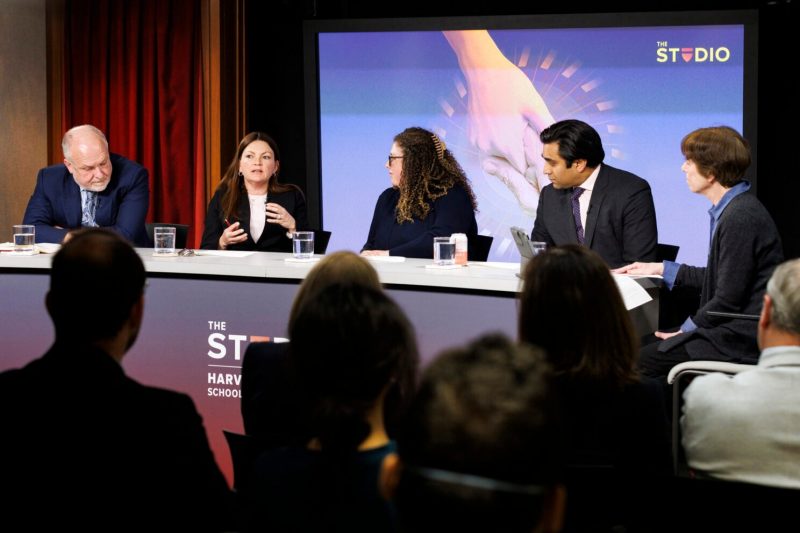Andrew Scott (from left), Marisol Amaya, Caitlin Coyle, and Ashwin Vasan discuss changing attitudes toward aging with moderator Kay Lazar.
Stephanie Mitchell/Harvard Staff Photographer
Health
America’s graying. We need to change the way we think about age.
Experts say instead of disability, focus needs to shift to ability, health, with greater participation, economically and socially
People in their 70s, 80s, and even 90s run marathons, write books, and go to work daily. But the predominant national conversation on aging focuses on disability rather than ability, something experts say is a problem as participation of America’s older adults grows more important, economically and socially, as the nation ages.
And it’s not just the young with the attitude problem. Caitlin Coyle, director of UMass Boston’s Center for Social & Demographic Research on Aging, said some of the biggest perpetuators of negative stereotypes are those growing older themselves.
“How we talk about it is powerful,” Coyle said Wednesday, as part of a discussion of the topic at the Harvard T.H. Chan School of Public Health. “We do a lot of internalized ageism with self-talk like ‘Oh, I feel so old today,’ or ‘I can’t do that,’ ‘I’m too old for that,’ or ‘I can’t stay up late.’ I think if we start to engage people in thinking about how they talk about aging outwardly — and also how they think about aging internally — we can really start to shift the societal narrative.”
The panelists at the event “A reexamination of aging: Living longer, happier, and healthier” agreed attitudes about aging set expectations for ourselves and others, but what’s also important are programs and policies crafted to encourage healthy aging — via prevention and risk-factor reduction, along with involvement in society, through work, volunteerism, family relationships, religious organizations, or other ways of engaging that can bring meaning to life.
“I think if we start to engage people in thinking about how they talk about aging outwardly — and also how they think about aging internally — we can really start to shift the societal narrative.”
Caitlin Coyle
“We are expecting to live much longer than our parents and grandparents. And the structures we put in place to support healthy aging are really crucial,” said New York City Health Commissioner Ashwin Vasan, a Chan School graduate and member of the panel. “At every turn, we are not just looking at the averted negative consequences of unhealthy aging, but looking at the aspirational, forward-looking indicators of healthy aging.”
The discussion hosted by The Studio at the Chan School was moderated by Kay Lazar, a reporter at The Boston Globe, and also featured Marisol Amaya, executive director of La Alianza Hispana, and Andrew Scott, professor of economics at London Business School and author of the book “The Longevity Imperative: How to Build a Healthier and More Productive Society to Support Our Longer Lives.”
Panelists acknowledged that declining health and rising disability are part of the landscape as one grows old, but Scott said it seems that when people think about aging they “go straight to the end” where those factors take on greater importance.
He attributed part of that to the “medicalization” of aging, which focuses on health problems and death. But what’s lost in between are, for many, years of increased life satisfaction, greater acceptance of oneself and others, decreased pressure to live up to ideals of how to look and behave, greater emotional stability during crises, and new opportunities to learn and develop new skills.
“The trouble with aging is we tend to go straight to the end of life. And that’s one of the reasons why we don’t like to think about a longer life being about having more future,” Scott said. “How do you think about that? How do you prepare for it? We see aging as an event — you’re 65 years old — but it’s a process that is relevant to all ages. What can you do to manage that process and how do you make sure you make the most of it?”
The tendency to view aging through a medical lens is not the only issue, however. Family structure in the nation has changed as people have fewer children and multigenerational living arrangements grow less common. This has led to an increasing tendency to segregate society by age and worsened the problem of isolation among the elderly.
At La Alianza Hispana, a social service agency focused on the Latinx community of Greater Boston, the elderly are provided programming based on individual preferences — bingo, for instance, isn’t for everyone and should be reserved for those who love it, Amaya said. Others want to play instruments, others to learn something new, and still others to teach.
Accordingly, the nonprofit’s elder-services program emphasizes flexibility, even hiring people still willing to work and able to draw on a lifetime of experience. Some are lacking in computer and other tech skills, but those can be taught, which the organization does, she said.
“We are flexible. We always encourage them to do more, empower them, because they see barriers and say, ‘I cannot do it,’” Amaya said.
As we create a society that is more elderly-friendly, Scott said thinking about the economics of living longer is important, since many fear outliving their resources.
But it’s also important to think about how to allow people to stay productive longer, which has to begin earlier in life by guarding one’s health through better habits, thinking about how to make jobs more age-friendly, and perhaps shifting roles from those that require strength to those that emphasize skill and experience.
A significant amount of attention must also be paid, panelists agreed, to reducing inequality in healthful aging. The trend toward healthier aging is not universal, with Black and brown communities making up a disproportionate number of those who die before 65, Vasan said. That highlights the importance of addressing preventative health in those communities in the decades before 65.
“I think inequity is a real missing piece in the dialogue, the public narrative, around longevity and aging,” Vasan said. “How do we create a civic expectation that healthier, longer lives are more equitably experienced? These are not mutually exclusive agendas. The equity agenda is central to the life expectancy agenda. There is no path that doesn’t go through equity. Addressing the causes of premature death gets us to healthier, longer lives for everybody.”





